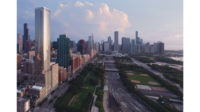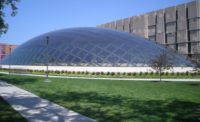Rising over 800 feet in a Medieval town in southwest Germany, ThyssenKrupp Test Tower is difficult to miss. In 2013, the multinational industrial conglomerate needed a facility to experiment with a rope-free high-speed elevator. Architects Helmut Jahn and Werner Sobek (who is also a structural engineer) responded to the call but insisted that the project also enhance its surroundings and provide a public service. “Given the beautiful landscape around Rottweil, it was clear to us from the beginning that the tower had to be more than just a technical structure,” says Sobek. The 69-foot-diameter reinforced-concrete tube houses the test facility at its center and is topped by an observation deck. The distinctive textile membrane shrouding the structure—which was completed earlier this year—is made of polytetrafluoroethylene (PTFE), and was designed to minimize thermal loads and deflect wind eddies to prevent oscillations that can occur during testing. And, as an object in the landscape, “the tower creates a new landmark,” says Jahn. “It enriches and continues the city’s history.”
Thyssenkrupp Test Tower by Werner Sobek with Helmut Jahn
Rottweil, Germany

Photo © Rainer Viertlböck




Post a comment to this article
Report Abusive Comment